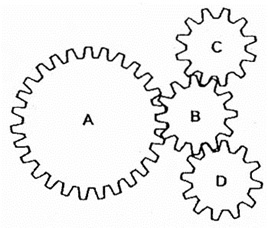ASVAB Mechanical Comprehension Test
The smaller gear has 8 teeth, and the larger gear has 16 teeth. When the larger gear makes 12 revolutions, how many revolutions will the smaller gear make?
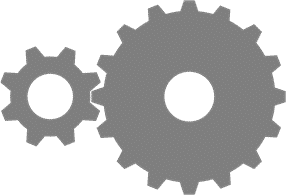
What is the advantage of a single pulley?
A single pulley changes the direction of effort: you pull the rope down in order to lift the object up instead of pushing up. The same amount of effort is required as without a pulley.
What is a component of potential energy?
An object’s potential energy is equal to its mass times its acceleration due to gravity times its height, or PE = mgh.
If a man uses 200 N of force over a distance of 50 meters, how many joules of work are performed?
Work is defined as the product of force in the direction of displacement. Here a force of 200 N is used over a displacement of 50 m. Consequently, the work performed is 200 N * 50 m = 10,000 J.
When torque increases, speed
The quantities of torque and speed are inversely proportional. When one increases, the other decreases.
The well pictured above uses what type of simple machine to raise and lower a bucket?
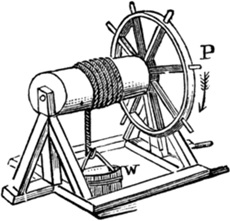
The well pictured here uses a wheel and axle system. The movement at the wheel becomes smaller than the movement on the shaft, increasing the force on the shaft.
At minimum, how many pulleys are there in a block and tackle system?
The block and tackle pulley system requires at least two or more pulleys. The bare minimum for this system is two.
What type of simple machine is pictured above?
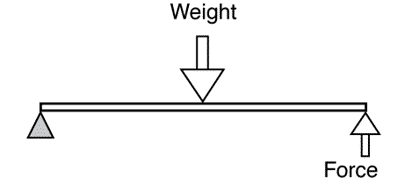
This machine pictured is a second-class lever. An example of a second-class lever is a wheelbarrow.
If a wedge is made longer relative to its height, how does the force increase?
When the distance of a life is the same as the distance the initial force travels, the force in will equal the force out. Making the wedge longer relative to its height (less slope) will change this by decreasing the amount of lift that takes place as the wedge is moved horizontally.
Weight is the
Mass is the amount of matter in an object; weight is the force exerted on an object due to gravity.
Which of the following describes the relationship between kinetic energy, mass, and velocity?
An object’s kinetic energy is defined as KE = ½(mv2 ). Reorienting, we find: 2KE = mv2 .
A fish tank at an aquarium contains several cubic feet of water (1 cubic foot of water = 62.5 pounds). If the fish tank is 6 feet deep, 12 feet wide, and 13 feet long, what’s the approximate pressure at the bottom of the tank in pounds per square inch?
To find the pressure (psi), we must divide the tank’s total volume by the surface area of the bottom of the tank. The volume = 6 x 12 x 13 = 936 feet. Multiply it by 62.5 to convert it into pounds: 936 x 62.5 = 58,500. The bottom of the tank’s surface area is 12 ft x 13 ft = 144 inches x 156 inches. Since pressure is in pounds per square inch (psi), we have to convert to inches. The surface area is 22,464 inches. The psi is 58,500 / 22,464 is approximately 2.6.
One horsepower is equivalent to
Horsepower is a unit used to rate internal combustion engines. One horsepower is the equivalent of 746 watts.
What is a vector quantity?
Gravity is a type of force, and since force has magnitude and direction it is known as a vector quantity.
Which of the following is the basis for Pascal’s Law?
The third principle of hydraulics is the basis for Pascal’s Law and states that when pressure is applied to a fluid, the pressure is transmitted evenly throughout – in other words, how force is amplified within a hydraulic system.
How much force is needed to lift the 10Kg weight?
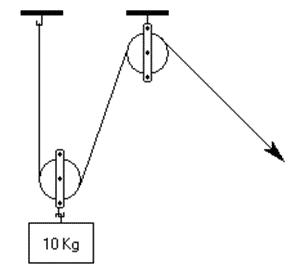
In a double-pulley system, the force is equal to the weight divided by two. It will require a 5 Kg force to lift a 10Kg weight.
An 80-lb child is sitting on one end of a seesaw. If another 80-lb child jumps from a high platform onto the other end of the seesaw, what will happen?
The force of the second child landing on the seesaw will propel the other end of the seesaw into the air.
If Gear A turns counterclockwise, what other gears turn counterclockwise?
